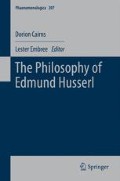Abstract
In evidence there is self-givenness of the object as intended, objects of indirect consciousness are not self-given, and hence such consciousness is not evidence. There are degrees of evidence for types of direct consciousness, e.g., the clear. Positionality, certain and dubitative included, varies with evidence, but this holds not only for the doxic but the non-doxic forms of positionality. Absolutely perfect evidence and absolute truth are ideals. Sensuous objects are inadequately given and the evidence imperfect, while universal essences can be given adequately and completely evident. Evidence can also be apodictic, indubitably certain, i.e., a cancelling self-givenness is inconceivable, and still inadequate beyond an apodictic core. There is also habitual evidence and indirect evidence.
Access this chapter
Tax calculation will be finalised at checkout
Purchases are for personal use only
Notes
- 1.
Cf. Chap. 1, 3f., on the notion of apodicticity.
- 2.
The brackets have been added by Cairns in the “A” version, but there is no indication why.—L.E.
- 3.
Cf. Chap. 1, pp. 3ff.
- 4.
Cf. Chap. 21.
- 5.
Pp. 65f.
- 6.
Morphologically speaking, not geometrically. Cf. pp. 132f.
- 7.
We are using perceiving in a wide sense, Mere sense-perception does not intend the patches of color as “symbols.”
- 8.
Cf. Chapter, pp. Cairns does not fill these in and it appears he tried to delete this note.—L.E.
- 9.
Cf. pp. 21f.
- 10.
Accordingly Husserl occasionally relativizes the sense of the phrase “original givenness,” and speaks, e.g., of intuitive recollection as bringing the past to original givenness, and of empathy (Einfühlung—in Husserl’s sense, cf. Chapter [Nothing listed by Cairns.—L.E.]) as bringing the conscious life of other egos to original givenness.
- 11.
P. 30f.
- 12.
P. 24.
- 13.
Except in the relative sense that retention and recollection are the most original possible awareness of the past as past.
- 14.
- 15.
Cf. Chap. 26.
- 16.
Just below this point in the left margin: “Compared with original and corrected to here, July 14, 1941.”—L.E.
Author information
Authors and Affiliations
Editor information
Editors and Affiliations
Rights and permissions
Copyright information
© 2013 Springer Science+Business Media Dordrecht
About this chapter
Cite this chapter
Cairns, D., Embree, L. (2013). Evidence. In: Embree, L. (eds) The Philosophy of Edmund Husserl. Phaenomenologica, vol 207. Springer, Dordrecht. https://doi.org/10.1007/978-94-007-5043-2_8
Download citation
DOI: https://doi.org/10.1007/978-94-007-5043-2_8
Published:
Publisher Name: Springer, Dordrecht
Print ISBN: 978-94-007-5042-5
Online ISBN: 978-94-007-5043-2
eBook Packages: Humanities, Social Sciences and LawPhilosophy and Religion (R0)

